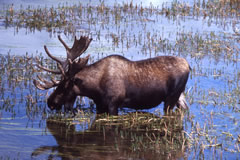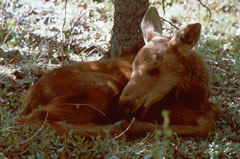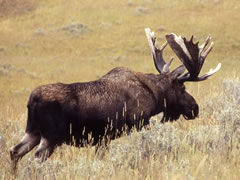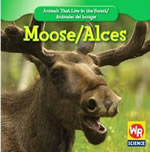Moose
Buffalo
Black-Footed Ferret
Caribou
Elk
Florida Panther
Grizzly Bear
Lynx
Moose
Red Wolf
Moose
(Alces alces gigas)
Moose are part of the deer family and are it's largest member. Both male and female moose have a skin flap called a "bell" that hangs down from their jaw. Males have large antlers that spread as wide as 5 1/2 feet. You can see a good pair of antlers on the bull moose photo to the right. Moose have long legs that allow them to wade through the water and are good in the winter to get through deep snow. Moose have a much better time in deep snow that elk do.
Moose Fun Facts:
- A bull moose can weigh more than 1400 pounds and it can be 6 feet tall at the shoulders and 6 to 9 feet long.
- Moose eat twigs and leaves of many plants including pin cherry, maple, birch, aspen, mountain ash, willow, gooseberry, lodgepole pine and various aquatic plants.
- Female Moose have 1 to 2 calves and they will stay for 1 year with the mother.
- Moose average life expectancy is around 8 years but have been known to live up to 18 to 20 years.
- While people are more afraid of bears more people are injured each year by moose than by bears. If you are too close to a moose (especially a cow with her young) and its hackles are up and its ears are laid back run away it is likely to charge.
Good National Parks to see Moose are:
Yellowstone National Park, Wyoming
Denali National Park, Alaska
Rocky Mountain National Park, Colorado
There is interesting success story regarding moose at the Rocky Mountain National Park. Looking at records back to 1850s it did not appear that moose were a major part of the ecosystem of the Rocky Mountain National Park. So in 1978 and 1979 a total of 24 moose were transferred from Wyoming to the Rocky Mountains National Park. As of 1994 the Colorado herd was estimated to be as large as 700 moose.

National Park Service Photo by Canter

Yellowstone National Park Photo

Yellowstone NP Photo - Ed Austin/Herb Jones

Yellowstone National Park by Jim Peaco
